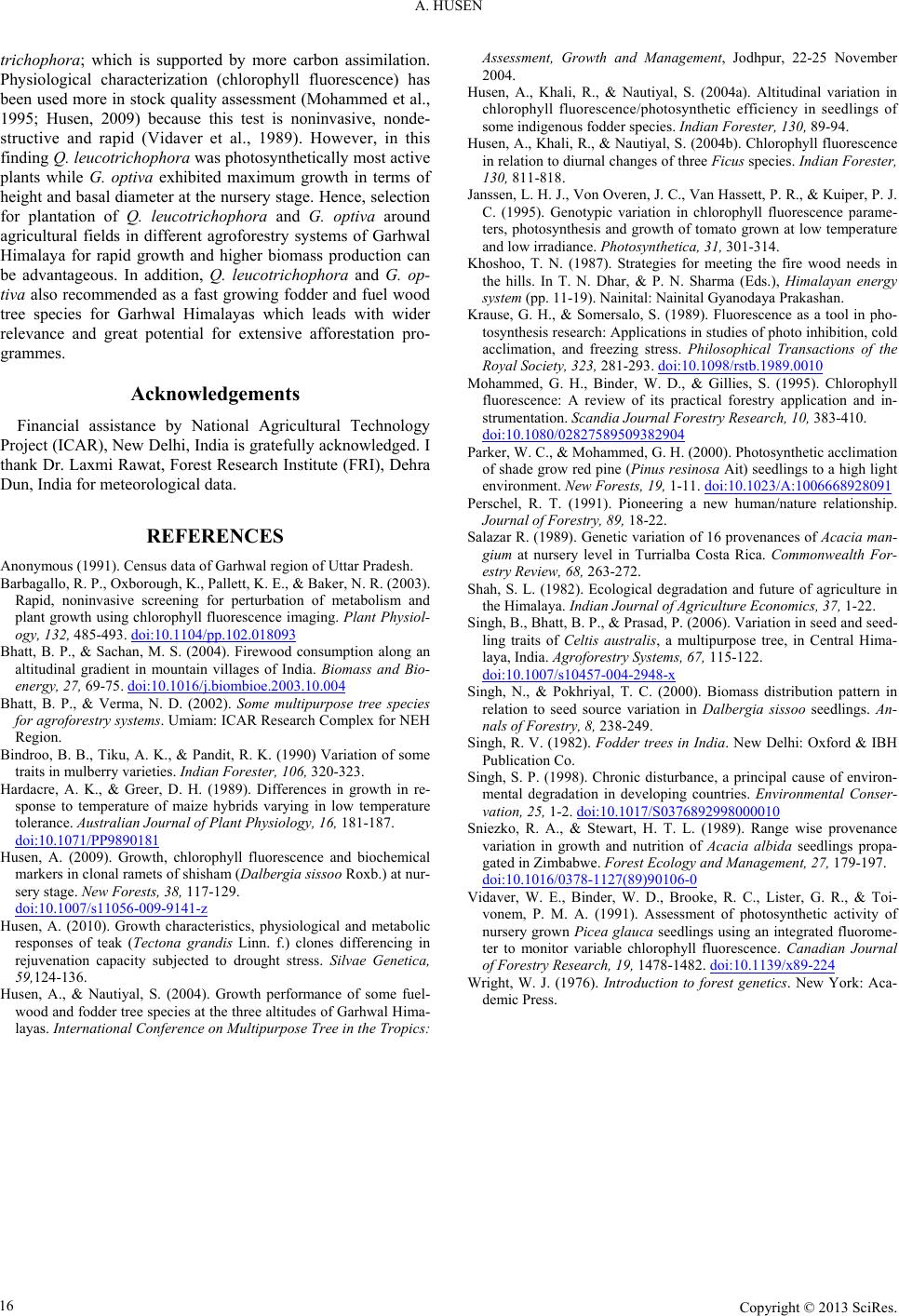
A. HUSEN
trichophora; which is supported by more carbon assimilation.
Physiological characterization (chlorophyll fluorescence) has
been used more in stock quality assessment (Mohammed et al.,
1995; Husen, 2009) because this test is noninvasive, nonde-
structive and rapid (Vidaver et al., 1989). However, in this
finding Q. leucotrichophora was photosynthetically most active
plants while G. optiva exhibited maximum growth in terms of
height and basal diameter at the nursery stage. Hence, selection
for plantation of Q. leucotrichophora and G. optiva around
agricultural fields in different agroforestry systems of Garhwal
Himalaya for rapid growth and higher biomass production can
be advantageous. In addition, Q. leucotrichophora and G. op-
tiva also recommended as a fast growing fodder and fuel wood
tree species for Garhwal Himalayas which leads with wider
relevance and great potential for extensive afforestation pro-
grammes.
Acknowledgements
Financial assistance by National Agricultural Technology
Project (ICAR), New Delhi, India is gratefully acknowledged. I
thank Dr. Laxmi Rawat, Forest Research Institute (FRI), Dehra
Dun, India for meteorological data.
REFERENCES
Anonymous (1991). Census data of Garhwal region of Uttar Pradesh.
Barbagallo, R. P., Oxborough, K., Pallett, K. E., & Baker, N. R. (2003).
Rapid, noninvasive screening for perturbation of metabolism and
plant growth using chlorophyll fluorescence imaging. Plant Physiol-
ogy, 132, 485-493. doi:10.1104/pp.102.018093
Bhatt, B. P., & Sachan, M. S. (2004). Firewood consumption along an
altitudinal gradient in mountain villages of India. Biomass and Bio-
energy, 27, 69-75. doi:10.1016/j.biombioe.2003.10.004
Bhatt, B. P., & Verma, N. D. (2002). Some multipurpose tree species
for agroforestry systems. Umiam: ICAR Research Complex for NEH
Region.
Bindroo, B. B., Tiku, A. K., & Pandit, R. K. (1990) Variation of some
traits in mulberry varieties. Indian Forester, 106, 320-323.
Hardacre, A. K., & Greer, D. H. (1989). Differences in growth in re-
sponse to temperature of maize hybrids varying in low temperature
tolerance. Australian Journal of Plant P hysiology, 16, 181-187.
doi:10.1071/PP9890181
Husen, A. (2009). Growth, chlorophyll fluorescence and biochemical
markers in clonal ramets of shisham (Dalbergia sissoo Roxb.) at nur-
sery stage. New Forests, 38, 117-129.
doi:10.1007/s11056-009-9141-z
Husen, A. (2010). Growth characteristics, physiological and metabolic
responses of teak (Tectona grandis Linn. f.) clones differencing in
rejuvenation capacity subjected to drought stress. Silvae Genetica,
59,124-136.
Husen, A., & Nautiyal, S. (2004). Growth performance of some fuel-
wood and fodder tree species at the three altitudes of Garhwal Hima-
layas. International Conference on Multipurpose Tree in the Tropics:
Assessment, Growth and Management, Jodhpur, 22-25 November
2004.
Husen, A., Khali, R., & Nautiyal, S. (2004a). Altitudinal variation in
chlorophyll fluorescence/photosynthetic efficiency in seedlings of
some indigenous fodder species. Indi an Forester, 130, 89-94.
Husen, A., Khali, R., & Nautiyal, S. (2004b). Chlorophyll fluorescence
in relation to diurnal changes of three Ficus species. Indian Forester,
130, 811-818.
Janssen, L. H. J., Von Overen, J. C., Van Hassett, P. R., & Kuiper, P. J.
C. (1995). Genotypic variation in chlorophyll fluorescence parame-
ters, photosynthesis and growth of tomato grown at low temperature
and low irradiance. Photosynthet ic a , 31, 301-314.
Khoshoo, T. N. (1987). Strategies for meeting the fire wood needs in
the hills. In T. N. Dhar, & P. N. Sharma (Eds.), Himalayan energy
system (pp. 11-19). Nainital: Nainital Gyanodaya Prakashan.
Krause, G. H., & Somersalo, S. (1989). Fluorescence as a tool in pho-
tosynthesis research: Applications in studies of photo inhibition, cold
acclimation, and freezing stress. Philosophical Transactions of the
Royal Society, 323, 281-293. doi:10.1098/rstb.1989.0010
Mohammed, G. H., Binder, W. D., & Gillies, S. (1995). Chlorophyll
fluorescence: A review of its practical forestry application and in-
strumentation. Scandia Jo u rnal Forestry Researc h, 10, 383-410.
doi:10.1080/02827589509382904
Parker, W. C., & Mohammed, G. H. (2000). Photosynthetic acclimation
of shade grow red pine (Pinus resinosa Ait) seedlings to a high light
environment. New Forests, 19, 1-11. doi:10.1023/A:1006668928091
Perschel, R. T. (1991). Pioneering a new human/nature relationship.
Journal of Forestry, 89 , 18-22.
Salazar R. (1989). Genetic variation of 16 provenances of Acacia man-
gium at nursery level in Turrialba Costa Rica. Commonwealth For-
estry Review, 68, 263-272.
Shah, S. L. (1982). Ecological degradation and future of agriculture in
the Himalaya. Indian Journal of Agriculture Economics, 37, 1-22.
Singh, B., Bhatt, B. P., & Prasad, P. (2006). Variation in seed and seed-
ling traits of Celtis australis, a multipurpose tree, in Central Hima-
laya, India. Agroforestry Systems, 67 , 115-122.
doi:10.1007/s10457-004-2948-x
Singh, N., & Pokhriyal, T. C. (2000). Biomass distribution pattern in
relation to seed source variation in Dalbergia sissoo seedlings. An-
nals of Forestry, 8, 238-249.
Singh, R. V. (1982). Fodder trees in India. New Delhi: Oxford & IBH
Publication Co.
Singh, S. P. (1998). Chronic disturbance, a principal cause of environ-
mental degradation in developing countries. Environmental Conser-
vation, 25, 1-2. doi:10.1017/S0376892998000010
Sniezko, R. A., & Stewart, H. T. L. (1989). Range wise provenance
variation in growth and nutrition of Acacia albida seedlings propa-
gated in Zimbabwe. Forest Ecology and Management, 27, 179-197.
doi:10.1016/0378-1127(89)90106-0
Vidaver, W. E., Binder, W. D., Brooke, R. C., Lister, G. R., & Toi-
vonem, P. M. A. (1991). Assessment of photosynthetic activity of
nursery grown Picea glauca seedlings using an integrated fluorome-
ter to monitor variable chlorophyll fluorescence. Canadian Journal
of Forestry Research, 19, 1478-1482. doi:10.1139/x89-224
Wright, W. J. (1976). Introduction to forest genetics. New York: Aca-
demic Press.
Copyright © 2013 SciRes.
16